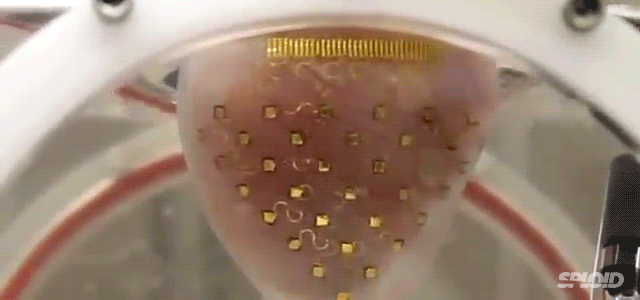You're looking at a rabbit's heart beating outside the animal that once hosted it. It's alive, pumping blood on its own thanks to a revolutionary electronic membrane that may save your life by keeping your heart beating at a perfect rate.

The thin, circuit-lined stretchable membrane has been developed by scientists at the University of Illinois at Urbana-Champaign and Washington University in St. Louis and may arrive to human hearts in 10 to 15 years.
They custom made it to precisely fit the shape of the rabbit's heart: First, while the rabbit was still alive, they scanned it and created a 3D model using computer aided tomography. They manufactured the model in a 3D printer, which they used as a mold to create the membrane. After that they took the heart out, applied the membrane, and kept it beating at a perfect pace.

But this device is not just a custom-made pacemaker. According to University of Illinois' materials researcher John Rorgers, co-leader of the team who has developed this device, it's like an artificial pericardium, the natural membrane that covers the heart:
Source: Gizmodo via Endo Riot
Related:

The thin, circuit-lined stretchable membrane has been developed by scientists at the University of Illinois at Urbana-Champaign and Washington University in St. Louis and may arrive to human hearts in 10 to 15 years.
They custom made it to precisely fit the shape of the rabbit's heart: First, while the rabbit was still alive, they scanned it and created a 3D model using computer aided tomography. They manufactured the model in a 3D printer, which they used as a mold to create the membrane. After that they took the heart out, applied the membrane, and kept it beating at a perfect pace.

But this device is not just a custom-made pacemaker. According to University of Illinois' materials researcher John Rorgers, co-leader of the team who has developed this device, it's like an artificial pericardium, the natural membrane that covers the heart:
But this artificial pericardium is instrumented with high quality, man-made devices that can sense and interact with the heart in different ways that are relevant to clinical cardiology.Washington University's biomedical engineer Igor Efimov says that it is a huge advancement. The circuits you're seeing are a combination of sensors that constantly track the tissues' behavior and electrodes that precisely regulate the heart muscles movement:
When it senses such a catastrophic event as a heart attack or arrhythmia, it can also apply a high definition therapy. So it can apply stimuli, electrical stimuli, from different locations on the device in an optimal fashion to stop this arrhythmia and prevent sudden cardiac death.
Source: Gizmodo via Endo Riot
Related:












COMMENTS